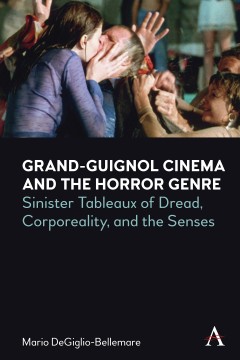Grand-Guignol Cinema and the Horror Genre
Sinister Tableaux of Dread, Corporeality and the Senses
By Mario DeGiglio-Bellemare
- About This Book
- Reviews
- Author Information
- Series
- Table of Contents
- Links
- Podcasts
About This Book
Grand-Gugignol Cinema and the Horror Genre traces important contributions of the Parisian Grand-Guignol theatre’s Golden Age as theoretical considerations of embodiment and affect in the development of horror cinema in the twentieth century. This study traces key components of the Grand-Guignol stage as a means to explore the immersive and corporeal aspects of horror cinema from the sound period to today. The book is a means to explore the Grand-Guignol not only as a historical place and genre, but theoretically, as a conceptual framework that opens up an affective mapping of Grand-Guignol attractions in cinema.
In a broader theoretical sense, Mario DeGiglio-Bellemare positions Grand-Guignol cinema in corporeal and affective terms as a way to discuss central themes from the Golden Age of the Grand-Guignol theatre as they figure within the framework of post-representational analysis in cinema studies. Post-representational analysis draws meaning out of matter, or the material intensities of films; here, making sense (representation and meaning) and also sensing (in a more corporeal, sensorial way) have political relevance that cut across gender, class, race and sexuality. The author deploys the Grand-Guignol as a conceptual tool to reveal its important influence on the horror genre by focusing on the dominant themes of the Grand-Guignol theatre that cinematic horror has taken up in its own immersive theatrics of the corporeal and sensorial.
This study’s restoration of a long Grand-Guignol tradition in cinema makes it a significant contribution to new theorizations of horror. It brings seemingly disparate traditions into conversation, as American, Canadian, French, and Italian cinema are all important sites for thinking through cinematic embodiment. These four countries have developed their own important genres and movements of Grand-Guignol cinema: the slasher, the “French Films of Sensation,” Canadian “body horror,” and the giallo. The Grand-Guignol famously operated in a dead-end of Chaptal Street, in the Pigalle district of Paris; this study offers affective and corporeal readings that open up new byways beyond the dead-end of psychoanalytic readings that continue to be dominant in horror genre scholarship.
Reviews
“To reckon with the horror film’s connections to the Grand Guignol theatre is to refigure our understanding of the horror genre. DeGiglio-Bellemare stages this reckoning with the sort of ambition, enthusiasm and a wide range of references that enrich horror studies. This is a stimulating and provocative book”— Adam Lowenstein, author of Horror Film and Otherness, Professor of English and Film/Media Studies, University of Pittsburgh, USA.
“This is a terrific book. While horror scholars frequently use the term ‘Grand-Guignol’ as a sort of shorthand – ‘Grand-Guignol effects,’ or ‘Guignol Treatment’ – we haven’t devoted the time and scholarship to fully unpack the Grand-Guignol’s lingering influence and affect in horror cinema. If that were all this book did, that would be enough to make it a necessary addition to the field. But DeGiglio-Bellemare also provides a rich and thick theoretical horror discussion – invoking Bataille, cultural studies, Marx and the rich scholarly history of the field. Well-written and immensely readable, this is a smart, sophisticated, well-conceived book – by a terrific scholar. Belongs on the bookshelf of every horror scholar and horror lover, and definitely belongs on the syllabus” — Joan Hawkins, author of Cutting-Edge: Art-Horror and the Horrific Avant-garde.
Author Information
Mario DeGiglio-Bellemare teaches courses in genre cinema, grotesque traditions, cinematic embodiment and monster ethics in the Humanities department at John Abbott College, Canada. He is also an independent filmmaker and the co-director of the Montréal Monstrum Society.
Series
Anthem Series on Exploitation and Industry in World Cinema
Table of Contents
Introduction: Grand-Guignol Cinema and the Senses Eyes Without a Face, Attractions, Affect and Facial Trauma; One The Grand-Guignol Theatre: A Short History of the Theatre and Spatial Ecologies of Dread The Hitch-Hiker and Shivers; Two Grotesque Carnivals of “Stubborn” Aurality: Embodied Discourse in Early Talkie Horror Cinema Murders in the Rue Morgue, Freaks, and The Black Cat; Three The Sight of Corpses in the Ruins of Modernity: Surgical Sadists under Censorship The Body Snatcher, and Mad Love, The Blood of the Beasts; Four Erotic Abattoirs of Bad Taste: Unproductive Potlatch in Exploitation Cinema Fascination, Grapes of Death, and Salò, or 120 Days of Sodom; Five French Colonial Skinning: Affect and Becoming-Wound in the Cinema of Sensation Trouble Every Day, Sombre, and In My Skin; Conclusion: Drag Performativity and Multisensorial Dread Blood and Black Lace and Psycho; Bibliography; Index
Links
Stay Updated
Information
Latest Tweets



